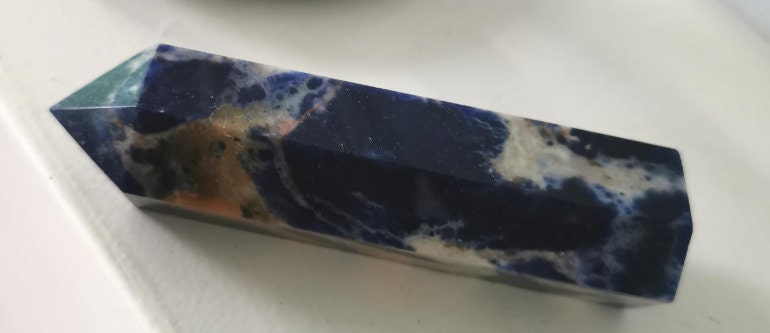Sodalite’s history dates back to ancient civilizations, though it gained prominence in the 19th century. The name ‘sodalite’ originates from its sodium content, a defining characteristic of the mineral. While it was not widely recognized in early human history, various indigenous cultures in the Americas and Europe utilized sodalite for its striking appearance and perceived mystical properties.The first significant deposits of sodalite were discovered in Greenland in the early 1800s, but it was Canada that brought it into the spotlight. In 1891, vast reserves of sodalite were found in Ontario, and it quickly became a popular ornamental stone. The gemstone gained further popularity when it was chosen as an official gift to Queen Alexandra of England, leading to its nickname, ‘Princess Blue.’
Sodalite is a member of the feldspathoid mineral group, meaning it forms in silica-poor environments, usually in igneous rocks such as nepheline syenites and phonolites. It is composed mainly of sodium, aluminum, silicon, and chlorine. The deep blue color of sodalite results from its unique chemical composition, and it often features white streaks of calcite, adding to its allure.Though most commonly found in blue, sodalite can also appear in shades of gray, green, yellow, and even pink. When exposed to ultraviolet light, some varieties exhibit fluorescence, displaying an orange or red glow.
Sodalite is cherished not just for its visual appeal but also for its believed benefits. These range from spiritual and emotional enhancements to practical uses in various industries.
Sodalite is often associated with the throat and third-eye chakras, making it a favorite among those who practice meditation and energy healing. Many believe that sodalite enhances intuition, insight, and mental clarity. It is said to help individuals access higher levels of consciousness, making it a valuable tool for spiritual growth.Furthermore, sodalite is thought to promote emotional balance. It is often used to calm the mind, reduce stress, and encourage rational thought. People who struggle with anxiety or overactive thoughts may find sodalite beneficial in grounding their energy and fostering inner peace.
Given its association with the throat chakra, sodalite is believed to aid communication. It is often recommended for individuals who struggle with public speaking or expressing their thoughts clearly. Writers, teachers, and speakers may use sodalite to improve their verbal skills and confidence.Additionally, sodalite is linked to truth and honesty. It is said to help individuals communicate more openly and authentically, strengthening relationships and fostering deeper connections with others.
Many crystal enthusiasts turn to sodalite for its supposed cognitive benefits. It is believed to enhance focus, logic, and analytical thinking, making it a useful stone for students and professionals alike. Sodalite is also said to encourage creativity and problem-solving, helping individuals overcome mental blocks and find innovative solutions.Some people also claim that sodalite aids memory retention and concentration, making it an ideal stone for those engaged in intellectual pursuits.
While the healing properties of sodalite are not scientifically proven, many people in the holistic health community believe that it has physical benefits. Some claim that sodalite supports the immune system, lowers blood pressure, and improves metabolism. It is also thought to benefit the throat, vocal cords, and larynx, making it useful for singers and speakers.Additionally, sodalite is said to help with insomnia by promoting relaxation and reducing nightmares. Placing a sodalite stone under the pillow is a common practice for those seeking restful sleep.
Beyond its metaphysical attributes, sodalite is widely used in decorative and industrial applications. Due to its vibrant color and striking patterns, sodalite is a popular choice for jewelry, carvings, and ornamental objects. It is also used as a semi-precious stone in interior design, particularly for countertops, tiles, and sculptures.Industrially, sodalite is sometimes utilized in the production of ceramics and glass. Its unique properties make it valuable in scientific research and technological applications.
To experience the benefits of sodalite, one can incorporate it into daily life in various ways:
Jewelry: Wearing sodalite in the form of necklaces, bracelets, or rings keeps its energy close to the body.
Meditation: Holding sodalite while meditating can enhance focus and spiritual insight.
Home Decor: Placing sodalite stones in living spaces promotes a calming atmosphere.
Personal Carry: Keeping a small sodalite stone in a pocket or purse serves as a reminder to stay grounded and focused.
Caring for sodalite involves gentle cleaning with lukewarm water and mild soap. Since it is a relatively soft mineral (5.5–6 on the Mohs hardness scale), it should be handled carefully to avoid scratches or damage. Exposure to harsh chemicals or prolonged sunlight can fade its color, so proper storage is essential.


